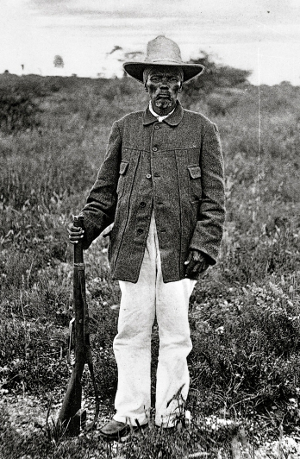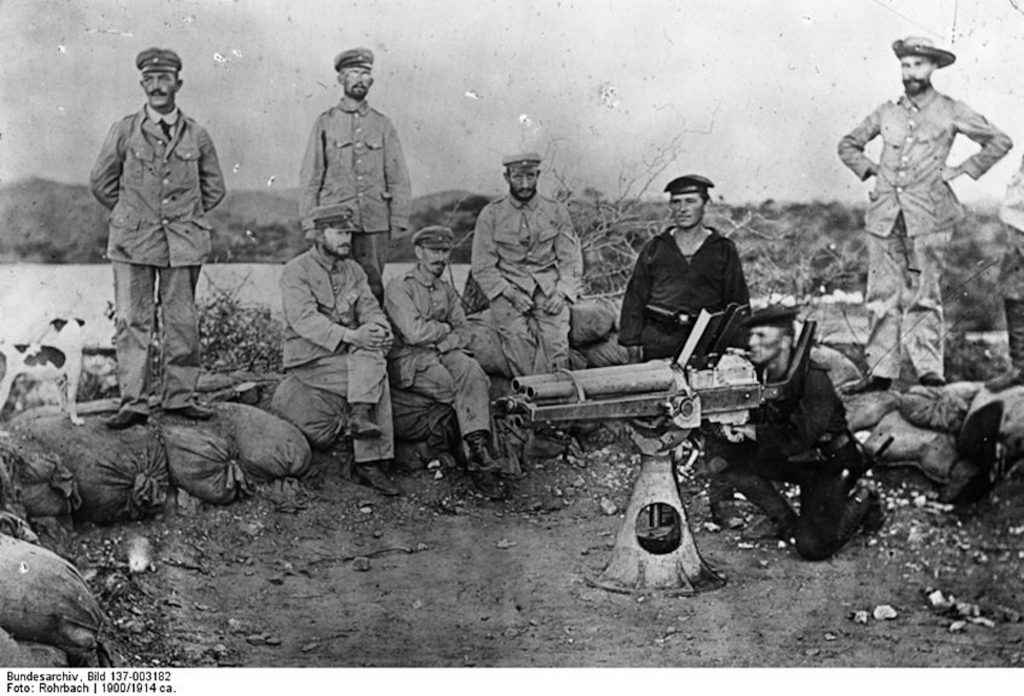
Depictions of colonized African peoples from Southwest Africa (DSWA, present-day Namibia), Germany’s first overseas colony, were prevalent throughout the German metropole at the turn of the twentieth century. Tobacconists catered to the erotic fantasies of colonial enthusiasts with images of Herero girls in their advertisements. Coffee companies used portraits of black African women to affirm the quality of their beans. Youth magazines allowed children to escape into “exotic” domains where their imaginations could wander unhindered by “civilized” social expectations. Anthropologists shifted the paradigms of scientific analysis by studying “natural peoples” as faceless objects. Novelists published romanticized accounts of faraway conflicts, a practice that over time made the realities of colonial bloodshed palpable for a continental audience. Though characterizations like these typified the contemporary discourse on Africa and epitomized Europe’s dominance over the continent, they belie the significant degree to which Africans in turn influenced the evolution of German imperial policy in southern Africa.
A focus on the Witbooi Namaqua—the largest ethnic group of the Khoikhoi community indigenous to the Cape Colony (present-day South Africa) and the Bechuanaland Protectorate (present-day Botswana)—offers an occasion to reorient our understanding of the relationship between Germany and its empire in southern Africa. In particular, they illustrate the prominent role of Africans in German colonial history and also reveal how peoples in distant places like Windhoek, Otjimbingwe, and Hoornkrans manipulated German efforts to control affairs in the colony. After the colonial administration raised the imperial flag in DSWA, the Witbooi tested the limits of German power using a variety of methods. They attacked rival communities aligned with the colonial government, rendered trade routes that ran through this territory impassable, forbade white settlers from prospecting on this land, and refused to sell cattle, supplies, and property to imperial forces. The Namaqua’s leader, Captain Hendrik Witbooi, also wrote letters to colonial officers, missionaries, and foreign diplomates where he mused on religious matters, his relationship with rival African societies, and the inherent violence of imperial occupation.
As Witbooi unmasked the realities of colonial life to settlers, German officials grew more determined to neutralize non-compliant African populations and increasingly relied on the colonial Schutztruppe (protection force) to impose their policies. It is not my intention to suggest that Africans made their own conditions worse through acts of resistance. Colonialism was an inherently violent enterprise that pressed entire societies into slavery, economic dependence, and cultural ruin. The conduct, practice, and rationale for imperialism may have differed from empire to empire, but all colonial powers pursued their national goals without the consent of colonized populations. It is also important to recognize that the Witbooi Namaqua were not the only group that challenged German imperial occupation. Many communities fought against German supremacy in Africa between 1884 and 1915. In fact, opposition to foreign rule was so relentless in DSWA that German administrators never gained full control of the colony until after Lothar von Trotha carried out the first genocide of the twentieth century.

Instead, my aim is to counter the persistent narrative that misrepresents colonized populations as passive victims in the face of German domination. Frederick Cooper and Ann Laura Stoler remind us that European colonial powers “were neither monolithic nor omnipotent.” They balanced a myriad of political agendas, economic strategies, and systems of control to maintain power in their respective empires. Germany’s occupation of DSWA exemplifies this argument in several notable ways. First, the appearance of German officials in DSWA did not immediately transform the political and social dynamics of the colony into one that favored the colonial government. Even after the first contingent of imperial soldiers in the Schutztruppe arrived in 1889, most local Africans, as well as resident German missionary associations, still regarded the Witbooi Namaqua as the most powerful society in southern Damaraland. Second, imperial leaders were at a loss over how to confront and overcome the persistent challenges to their authority. Witbooi’s refusal to accept German rule, along with his stubborn efforts to spread the Namaqua’s authority into central and northern Damaraland in particular, induced policy makers to consider a wide range of strategies. German officials not only tried diplomatic outreach and bribery, but also issued blanket threats—all in an attempt to pressure Witbooi to submit peacefully. When those policies failed, they sanctioned the use of armed aggression to drive the Namaqua from power. As more soldiers and military equipment landed in the colony, the role of the imperial regime grew in size and scope.
Though colonialism was a controversial issue in the Kaiserreich, the increased attention given to Africa in newspapers and political speeches elevated the Witbooi Namaqua’s acts of resistance into a national story. As calls to suppress them grew louder in the colonial and national press, the German government moved to expand its role in southern Africa, culminating in its declaration of DSWA as a settlement colony in March 1893. In the span of nearly ten years, what had started as a minor commercial enterprise in a faraway African territory had grown into an important extension of the German state. The Witbooi Namaqua played a significant role in this political transformation: their refusal to accept German authority forced colonial officers to confront their administrative limitations in the colony and to question the purpose behind imperial rule in southern Africa. Most significant, however, the Namaqua shattered the illusion of German cultural superiority. After 1884, settlers and colonial officials quickly discovered that they could not govern merely on the basis of their national convictions or sense of adventure. When the façade of imperial fantasy gave way to colonial reality, German policy makers realized that they needed to increase the scope of the colonial government to subdue the Namaqua. African resistance compelled imperial authorities to react with military force, a response that only a small minority celebrated in Germany. In spite of its controversial reception, however, armed aggression emerged as the principal instrument that colonial authorities used to defend their African empire by the turn of the twentieth century.
* A longer version of this blog post can be found in Central European History, 2017, pages 449-470.
Dr. Adam A. Blackler is an assistant professor of history at Black Hills State University. His book manuscript, Heathens, “Hottentots,” and Heimat: The Boundaries of Germanness in Southwest Africa, 1842-1915, exposes the other side of imperial domination by looking specifically at how Africans confronted German rule. He will start a new position in the department of history at the University of Wyoming in Fall 2018.

Comments